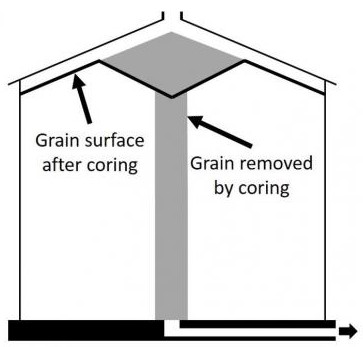By Shawn Shouse and Kristina TeBockhorst
2020 corn harvest in Iowa is likely to include increased amounts of damaged grain from the drought, derecho, or excessively dry corn at harvest. As grain bins are filled, fines and broken or damaged kernels tend to accumulate near the center of the grain pile, while whole and higher quality kernels tend to slide to the outer edges of the pile. This leads to a concentration of low quality and damaged grain in the center core of the bin. Additionally, with the greater depth of grain under the center of the peaked fill, this central core receives less airflow and is at much higher risk for spoiling. Reduce this risk by coring the bin as soon as it is filled.
Coring the bin removes the narrow cylindrical core of grain extending from the grain surface down to the unloading sump. The center peak will be the first grain drawn down through this core to the unloading auger. Unload until half of the grain peak is removed and the grain surface makes a “W” shape. This serves two purposes. First, the center core of grain with the highest concentration of fines and damaged kernels is removed. Second, the grain depth at the center of the bin is now roughly equal to the grain depth at the sidewall, making the overall grain depth more uniform. Both results increase aeration uniformity and reduce the risk of grain spoiling during storage.

The number of bushels removed with half of the peak height to properly core the bin is a function of bin diameter. The bushels to remove when coring is equal to the bin diameter (in feet) cubed, divided by 90. Bushels = (diameter x diameter x diameter) / 90. For a bin with sidewall height roughly equal to diameter, coring bushels equals about 1.5 percent of bin capacity. If sidewall height is only ¾ of bin diameter, coring would remove about 2 percent, and if sidewall height is 1.5 times diameter, coring would remove about 1 percent. Core each of your bins this fall and contact your Extension field Ag engineer for more information.